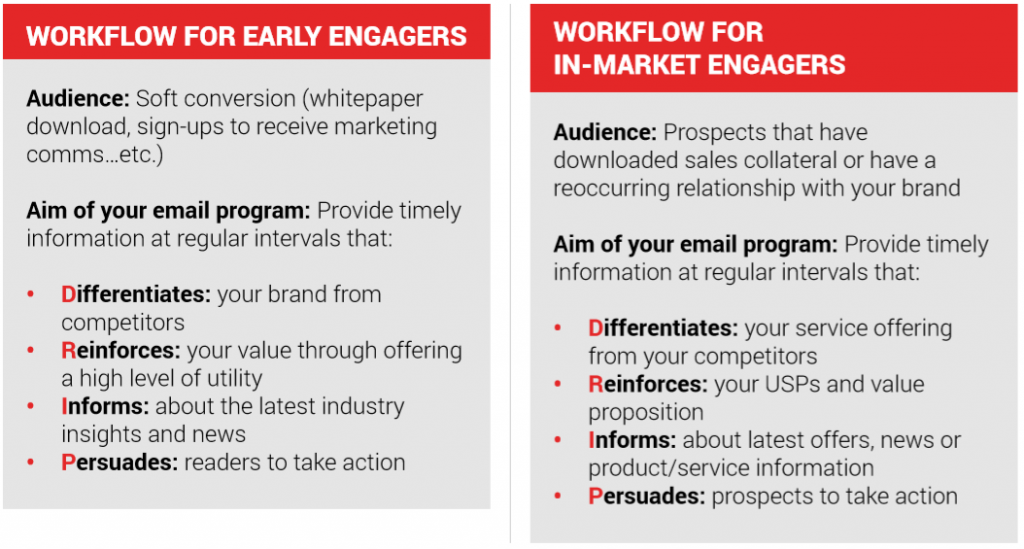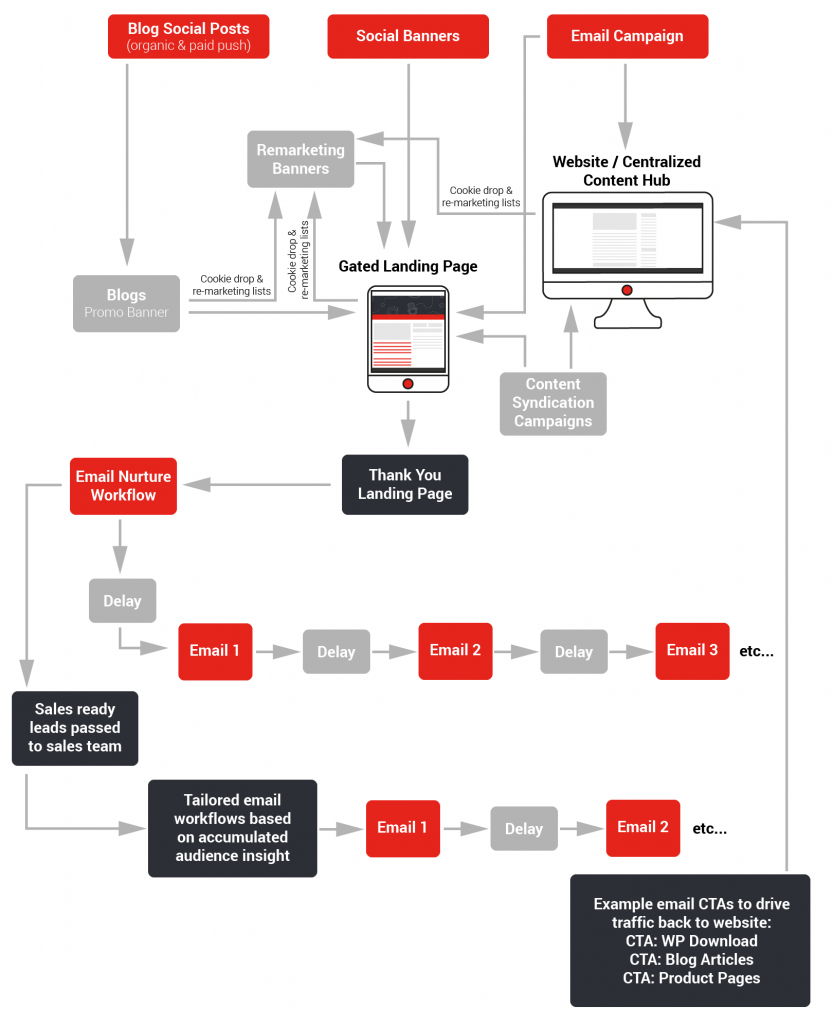Lead generation is an essential element of demand generation but if you think the work stops there, you’re mistaken…
Nurturing your active leads and potential buyers is almost as important as acquiring them in the first place, with a recent Forrester report finding that lead nurturing generated 50% more qualified leads at 33% less cost.
But before you hang up your coat and miss out on another potential sales opportunity, here’s a collection of lead nurturing best practices worth exploring.
Reading time: 5 minutes
What is lead nurturing?
74% of companies say converting leads into customers is their top priority (Hubspot).
However, not all businesses are getting it right…
Running a high response lead generation campaign resulting in downloads of your premium content is often not enough to expect a high ROI. 96% of visitors who come to your website aren’t ready to buy but are likely to exchange contact info for valuable content (Marketo).
This is because attention spans are short and competition is hot, especially if you operate in the tech or eLearning space.
As B2B marketers, we have to work harder to sustain the interest of our target audiences and prospective customers through delivering a range of intelligent communications triggered at crucial touchpoints in the sales funnel.
The purpose of lead nurturing communications is to continuously demonstrate your company’s value through a series of optimized value exchanges that guide your leads (and their influencers) towards your desired destination – a sale.
Through continuously giving them what they want to hear at the touchpoints they want to hear it, you are in prime position to seal that deal.
How has B2B lead nurturing changed?
Traditionally many lead nurturing programs work on the assumption of a relatively simple sales funnel, where prospects “at one stage” are encouraged to move “to another stage”.
Today, B2B front runners are jumping in a lot sooner and are leveraging more pervasive media tactics to engage, motivate and entice audiences. Why?
This is because today’s buyers are facing more complex buying situations. There’s more stakeholders involved in the decision making unit, there are more stages in the buyer cycle and there are more external factors shaping the way stakeholders perceive, interpret and interact with vendors.
In our article ‘You’re Looking at the Funnel the Wrong Way’ we showed how B2B buyers no longer follow a linear path to purchase, rather they jump, skip or repeat stages according to their fluctuating information needs and pressurized buying environments.
The strongest B2B lead nurturing approaches understand the need to diversify the marketing toolkit to embrace multichannel tactics to build an always-on, always present environment that keeps your brand front-of-mind, both in and out of their inboxes.
Do email nurture programs still work?
Email workflows are great at providing timely automated communications that drip-feed relevant information that generates long-term value exchanges with your audiences.
6 key benefits of email nurture workflows
- Drive traffic back to your website where they can find more information that aids decision making
- Promote relevant content that provides value to your readers, e.g. blog posts
- Provide a point of contact from your company
- Send tailored offers or exclusive promotions
- More personalized emails for prospects
- Stay front of mind even when prospect is off your website
Email nurture workflow programs can vary massively in size and complexity due to your available resource and marketing automation platform.
However, there are two main approaches to bear in mind, no matter what your ambitions:

The above approaches demonstrate the need to distinguish where your audiences are in the buyer journey and to adopt a specific set of tactics to keep them engaged and moving through your sales process.
When you are developing your lead nurturing program, one of the key things to define is the point you hand over to sales. Most automated nurturing systems enable you to score leads based on their interactions with your content, so think about how you will score different actions and what different behaviors might mean.
You can also use nurturing programs to cumulatively gather more information on potential customers without being invasive, so that you can make future communications even more targeted.
This information should be captured against each contact so both your sales and marketing teams are equipped with the very best insight to help build a winning rapport. You may decide to keep SQLs in a marketing workflow that provides a steady supply of background information that continues to provide value to your readers throughout their duration in the sales pipeline.
However, make sure your sales team are fully informed about the communications your SQLs are receiving. Keep them updated with openers, clickers, unsubscribers and content downloaders on a regular basis. This will help ensure everyone is on the same page and your messaging remains consistent.
Further reading: 4 Principles for Nurturing Leads [Download]
Should I be going beyond email nurturing?
Email nurture is a highly effective digital marketing tactic at keeping you front-of-mind and delivering your tailored messaging to your specified audiences.
However, to really leverage the full potential of lead nurturing we recommend building out your channel ecosystem and joining up your data points to deliver a fully immersive environment.
In order to accommodate the complex and often fluctuating needs of your target audience, it’s worth considering the use of cookies and intent data to deliver timely messages in addition to your email workflows.
The ubiquitous potential of intelligent automated display has helped many of the world’s most successful brands create immersive multi-touchpoint environments that propel the right opportunities through their B2B demand generation engines.
Re-marketing may not be new but the technology behind it drives fresh, relevant insight if used wisely.
An intelligent re-marketing or nurture strategy is designed to drive value into your audience and connect interest with more information. Advanced re-marketing and nurture looks at delivering relevant messaging based on where the user sits within the content journey.
Market research shows targeting users with relevant content for their position along the buying process yields 72% higher conversion rates (Aberdeen).
A topic or category re-marketing approach drives better alignment with your audience needs and a timely relevant CTA with a reason to engage, based on insight, ultimately drives better response.
How can I start building out a multichannel nurture program?
Think about data points you have at your disposal and how you can join these up with your owned, paid and earned channels. It’s vital you have a strong understanding of your target audience’s buying cycles so you can identify key touchpoints to engage and win their interest.
Taking a holistic approach to your planning will help you create a lead nurture system that keeps your audience in your carefully considered digital ecosystem. This can be achieved through creating a network of intelligent conversion points that aim to seamlessly connect to minimize drop out and sustain engagement.

This is just one example of how you can create a digital ecosystem. However, the best strategies leverage the most accurate audience insights to inform the most effective conversion paths for your target audience. This can often require bringing together both first and third-party data and leveraging a combination of owned and paid channels to achieve your ultimate goal – revenue!
For more support on creating immersive content-rich environments that keep your target audience engaged throughout their buyer journey, book a call with our demand generation specialists.
We also have more demand generation tips in our latest guide, the 7 Pillars of Successful Demand Generation






